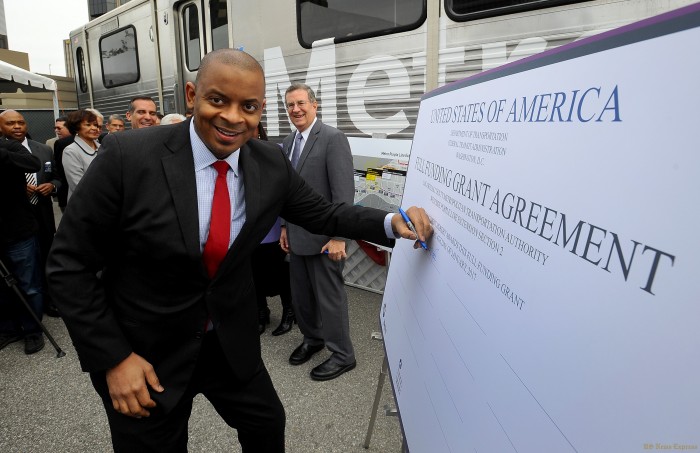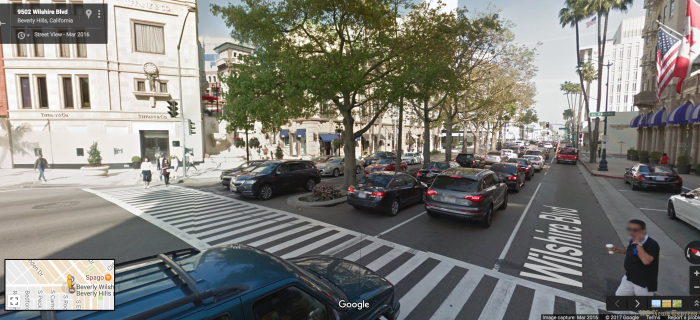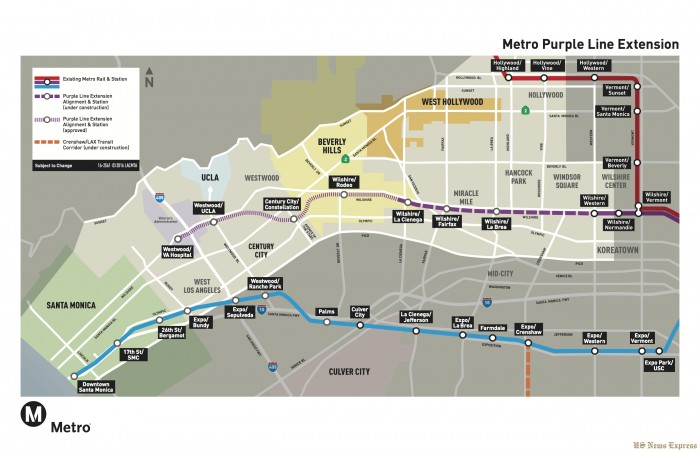
LOS ANGELES-A federal grant and loan totaling nearly $1.5 billion to help build the second phase of the Metro Purple Line Extension to downtown Beverly Hills and Century City was announced today by the U.S. Department of Transportation and the Los Angeles County Metropolitan Transportation Authority.
Metro received a construction grant agreement for $1.187 billion through the Federal Transit Administration’s (FTA) Capital Investment Grant program and a $307-million loan through the U.S. Department of Transportation’s TIFIA program to total $1.494 billion. The project will also receive $169 million in federal funding through the Congestion Mitigation and Air Quality program.
Coupled with Metro’s $747 million local match made possible by 2008’s Measure R sales tax, $2.4 billion is now secured to continue construction of one of L.A. County’s most critically needed public transit projects – a subway primarily under Wilshire Boulevard that will finally connect downtown Los Angeles and Westwood with service en route to the Miracle Mile, Beverly Hills and Century City.
Metro is now in the process of selecting a contractor to build the subway extension’s second section. The agency plans to recommend a contractor to the Metro Board later this month.
“Metro greatly appreciates the funding provided by our transportation partners in Washington D.C.,” said John Fasana, Metro Board Chair and Duarte City Council Member. “By smartly matching federal dollars with Metro’s local sales tax proceeds, we will be able to deliver fast, frequent and high-capacity subway service as promised to L.A. County residents on an accelerated timeline.”
Metro is already building the first section of subway between the current subway terminus at Wilshire/Western and Wilshire/La Cienega with three new stations. The second section will add another 2.6 miles to the project and build two new stations at Wilshire/Rodeo in downtown Beverly Hills and Century City.

Pre-construction activities for the second section are already underway. Major construction is planned to begin in 2018. Completion of the second subway section is anticipated no later than 2026 per the FTA Full Funding Grant Agreement and Metro is aiming to possibly finish the project at an earlier date. A third and final section will extend the subway to the Westwood/VA Hospital. Construction on this last section is planned to begin as early as 2019.
“Angelenos and people across L.A. County have shown their commitment to creating a better-connected transportation system — and this investment echoes that commitment to giving people faster, more convenient connections to their jobs, to healthy recreation and fun attractions, and to the people they love,” said Los Angeles Mayor Eric Garcetti, who serves as Metro First Vice Chair. “We are moving quickly to create the world-class transit system our people deserve, and these federal funds for the Purple Line extension will accelerate progress along the region’s busiest transit corridor.”
Construction of the Purple Line Extension Section 2 will support over 20,500 jobs in Southern California during its construction, according to the Los Angeles County Economic Development Corporation.
“Securing funds for this $2.4-billion project was a truly collaborative effort, bringing together stakeholders at the local, state and federal levels,” said Sheila Kuehl, L.A. County Supervisor and Metro Board Member. “I can’t wait for the day when the Purple Line will begin to serve Wilshire Boulevard, one of the busiest and most congested corridors in Los Angeles County.”
The Purple Line Extension to the Westwood/VA Hospital station will garner about 49,300 daily weekday boardings at the seven new stations. There will be about 78,000 new daily trips on the full Metro Rail System as a result of opening this line.
A total of $3.1 billion in federal New Starts funding has now been secured for recent high priority Metro transportation projects.
“I’d like to personally thank the U.S. Department of Transportation and Federal Transit Administration for working hard to ensure this funding agreement moved forward in a deliberate and effective manner,” said Metro CEO Phillip A. Washington. “This and previous federal project funding represents years of hard work, and is the keystone to Metro’s countywide program to transform transportation in our region.”
Trains are expected to run every four minutes during peak hours on the Purple Line Extension and every 10 minutes during off-peak times. The Metro Board last month approved a contract for new subway vehicles to help support the line and the agency is also working on a project that will allow subway trains to turn around more quickly at Union Station, thereby increasing capacity on the line.
Over 300,000 people travel into the Westside every morning for work from throughout the region. More than 100,000 trips also leave the area for outside destinations. The Purple Line extension will offer improved connectivity to the entire Metro Bus and Rail network, as well as transfers to municipal bus lines and other regional transportation services.
The Los Angeles County Metropolitan Transportation Authority (Metro) is unique among the nation’s transportation agencies. Created in 1993, Metro is a multimodal transportation agency that transports about 1.3 million passengers daily on a fleet of 2,200 clean air buses and six rail lines. The agency also oversees bus, rail, highway and other mobility-related building projects and leads transportation planning and programming for Los Angeles County.




















